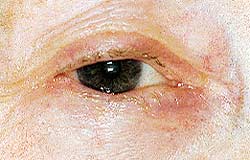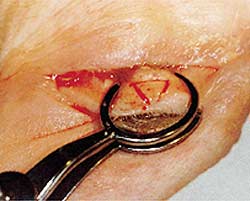Mideyelid entropion can be surgically repaired
The condition is often asymptomatic, but some cases require a surgical solution.
Mideyelid entropion, a distinct entity involving the central 3 mm to 5 mm of the lower eyelid, causes minimal symptoms and usually does not require any treatment. This article reviews the clinical entity of mideyelid entropion and two cases that required surgical correction. The method used will be described.
Mideyelid entropion occurs in the elderly without any history of previous eyelid trauma or inflammation. The central anterior eyelid lamella of skin and eyelashes turns inward and touches the bulbar conjunctiva and cornea. There is segmental attenuation in thickness of the underlying tarsus with characteristic notching of the eyelid margin. The meibomian glands appear atrophic on slit-lamp examination.
The anatomical and histological studies of Huang et al demonstrated a decrease in length and height of the tarsus of the lower eyelid with involutional entropion; however, they did not show any segmental atrophy as seen in mideyelid entropion. Mideyelid entropion does not progress to full eyelid entropion as is seen with the involutional type.
Most cases of mideyelid entropion are asymptomatic and do not require treatment. The two cases that will be reviewed here had persistent foreign body sensation, conjunctival injection and corneal epithelial erosion not alleviated by use of topical emollients or repeat epilation.
|
Method
Surgically, we resected the abnormal attenuated tarsal tissue and underlying orbicularis. After topical anesthesia to the conjunctival surface and local infiltrative anesthesia, a trapezoid, base down, of conjunctiva, tarsus and orbicularis was resected, including the area of the attenuated tarsus.
The incisional edges were undermined and reapposed with three 5-0 silk sutures and one 6-0 silk suture through the upper tarsal border to reconstruct the eyelid margin. This method is similar to the surgical repair of entropion described by Fox.
Partial hemostasis was achieved with the use of a chalazion clamp. A topical antibiotic ointment was instilled, and a dressing applied for several hours.
Case reports
One case was a woman in her 90s. Her medical history included treatment for pernicious anemia. She had undergone bilateral cataract surgery with implants.
The patient complained of tearing in both eyes. Ocular examination was normal except for mideyelid entropion bilaterally with trichiasis. Slit-lamp evaluation revealed superficial corneal vascularization in the area of the entropion in both eyes. Recurrent corneal epithelial abrasions in the zone of eyelash contact required medical treatment. She subsequently had surgical repair as described above, and she was asymptomatic at 3-year follow-up.
Another case was a woman in her 80s. Her medical history included treatment for coronary artery disease including bypass surgery. She had undergone cataract surgery in the right eye. There had been no past treatment for trauma or infection of eyelids.
Two years after cataract surgery, this patient presented with recurrent irritation and foreign body sensation of right eye. Examination revealed mideyelid entropion with corneal epithelial abrasion. The use of topical emollient ointments did not give sufficient symptomatic relief, and surgical correction with a resection of the pathological tarsus as previously outlined was performed.
There has been no recurrence during a 6-month follow-up period.
For Your Information:References:
- Seligman Rosenberg, MD, FACS, can be reached at 301 Bridge Plaza North, Fort Lee, NJ 07024; (201) 941-0562; fax: (201) 947-5507.
- Rosenberg S. Sanchez M, Henick A. Mideyelid Entropion. Ophth Plastic and Reconstructive Surgery. 1990;6:21-24.
- Huang T. Amayo E, Lewis S. A histological study of the lower tarsus and the significance in surgical management of involutional entropion. Plast Reconstr Surg. 1981;67:585-90.
- Fox S. Correction of senile entropion. Arch Ophthalmol. 1952;48: 624-28.


